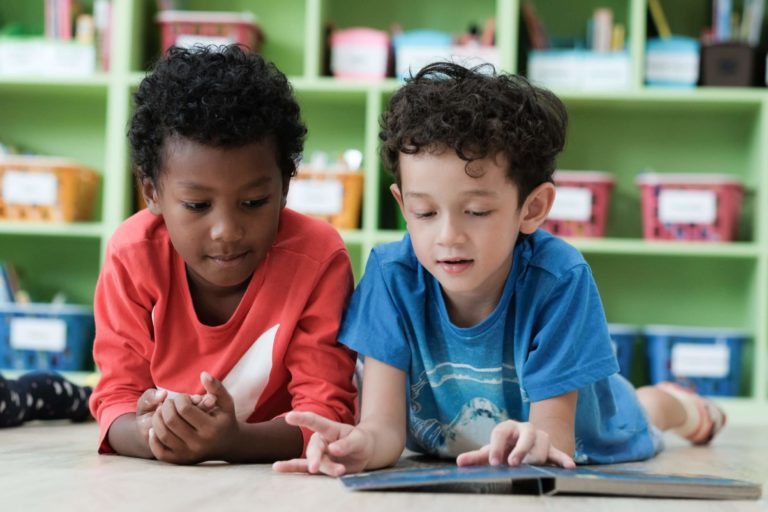What are Decodable Books?
Decodable books are books that are written with a focus on a particular phonetic pattern or word family. Each decodable book is written using specific sound-letter relationships throughout the entire text. These phonics patterns on the pages of these books include word families with short vowels, long vowels, vowel teams, or irregular sounds.
Decodable books are great tools for early readers or struggling readers because the words are easier to decode. They are most often found in primary classrooms. Children can independently read decodable books and practice their phonics knowledge. The repeated readings of decodable books help beginning readers with their automaticity or fluency of word recognition, specifically in phonics patterns and high frequency words.
What are Leveled Books?
Leveled books are books characterized and categorized by the level of difficulty of the text. Based on a number of criteria, leveled books range from guided reading levels A-Z or DRA (developmentally reading assessment) levels 1 to 70. Educators use diagnostic literacy tools measuring a child’s accuracy, fluency, and comprehension to determine the child’s three reading levels.
Independent, instructional, and frustration levels are used to match the appropriate leveled book to each child. As the word knowledge, vocabulary, and sentence structure increase in difficulty, the level of the book increases. Leveled books match the developmental journey of a reader from kindergarten through middle school. Children’s trade books are now often leveled to support the guided reading instruction in classrooms and leveled libraries in elementary schools around the country.
When to Use Each Kind
It should be evident that decodable books and leveled books are not interchangeable; they each serve a valuable purpose in the teaching of reading. There is one major difference between the two types of books, however. Decodable books have a singular focus on one particular phonics pattern while leveled books combine specific phonetic patterns, sentence fluency, and vocabulary in a particular text. These components are measured to determine the level of difficulty of reading, which results in the determination of the text level.
They also serve two different roles in the classroom. Students can read decodable books on their own to practice a specific phonics pattern or word family they have previously been taught through direct instruction. Leveled books are most often used at the guided reading table where a teacher facilitates reading instruction on students’ instructional level.
Teachers are constantly making observations and taking anecdotal notes of each student during guided reading time to ensure the child is appropriately matched the correct leveled book to increase reading engagement and success. Once a child has at least a 95% accuracy rate on a leveled text, the teacher can assess to determine if the child should turn that instructional leveled book into an independent reading book and move the text up one level for guided reading instruction.
Classrooms often use individual book boxes for students to house their leveled reading books for independent reading time. The teachers store the leveled books for each reading group they see at the guided reading table. These are constantly changed as reading groups and reading levels are very fluid, especially in the primary classroom. Many times, the classroom library also has a collection of children’s books in bins labeled by a reading level number or letter.
A primary classroom, usually between kindergarten and second grade, should balance the use of decodable books and leveled books. The implementation of the decodable books should match the word study or phonics instruction, which could be taught whole group, while the leveled books match the individual reading plan of the students. Students can use decodable books to increase their fluency or automaticity of reading on their own or with a partner. They can also use this style of text to go on a “word hunt” where they circle or highlight the targeted phonics pattern on each page.
To extend the phonics practice, students can make a list of every word that follows the same sound-letter relationship or word family. In the primary classroom, the leveled book may also use the same phonics patterns in words throughout the text, which should now be easier for children to decode. While a decodable book is often used for a week of practice in the classroom, the instructional leveled books in guided reading are usually switched every two to three days. The level usually remains the same for three to four weeks in the primary classroom.
While the use of leveled books continue to be used throughout a child’s elementary school reading career, decodable books are seen much less in third, fourth, and fifth grade classrooms. This is because basic phonics patterns are usually taught prior to third grade. An exception may be for a student identified for special education services or as an English language learner. As the leveled increases in number or letter in upper grades, a child will often stay in a leveled book for a longer period of time focus on comprehension of text rather than word attack skills. The progression of the leveled books informs the teacher the specific phonics patterns or comprehension strategies to implement in guided reading instruction to help a child maintain reading growth.
While these are the common uses of the two texts in classrooms, it is important to remember that reading is developmental. Therefore, we need to remember how effective decodable books can be for a third-grade student struggling on a particular vowel pattern. Secondly, while we could have a second-grade student reading at a kindergarten level, we want to select a leveled book that matches not only their instructional level, but also their engagement or interest level. When teachers use both tools to support differentiated literacy instruction, a love and confidence of reading are present in the classroom.




